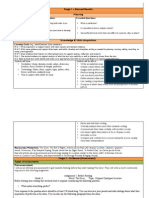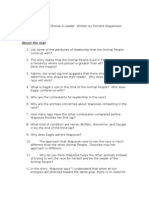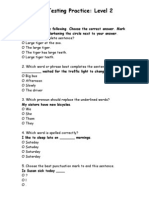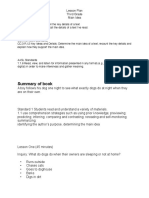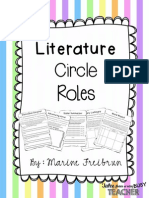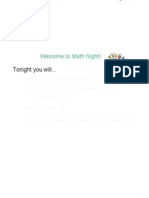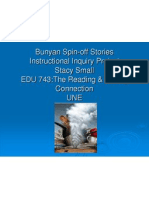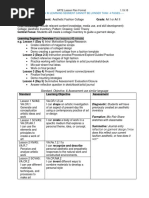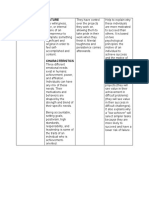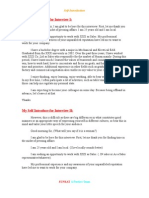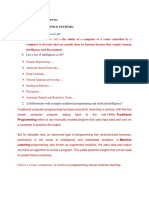Mini-Unit Character Trait Vocab
Mini-Unit Character Trait Vocab
Uploaded by
api-88644317Copyright:
Available Formats
Mini-Unit Character Trait Vocab
Mini-Unit Character Trait Vocab
Uploaded by
api-88644317Original Title
Copyright
Available Formats
Share this document
Did you find this document useful?
Is this content inappropriate?
Copyright:
Available Formats
Mini-Unit Character Trait Vocab
Mini-Unit Character Trait Vocab
Uploaded by
api-88644317Copyright:
Available Formats
Mini-Unit: Developing a Character Trait Vocabulary
Mini-Unit: Developing a Character Trait Vocabulary
Stacy (Godin) Small EDU 740 Supporting Students Literacy Development University of New England 10/16/2010
Mini-Unit: Developing a Character Trait Vocabulary
Abstract
One of the most continual findings in reading research is that students vocabulary knowledge relates strongly to their reading comprehension and overall academic success. Vocabulary knowledge contributes to reading success in other important ways as well. Strong vocabulary knowledge impacts phonological awareness, decoding text, and reading engagement. Young students who have a large number of words in their oral vocabularies may analyze the representation of the individual sounds of those words more easily (Goswami, 2001; Metsala & Walley, 1998). Also students with a large oral vocabulary can more easily and quickly decode, read, and understand these words when they encounter them in print. Lastly, students who do not have large vocabularies often struggle to understand what they read and therefore often avoid reading. Because they do not read as much as their vocabulary-rich peers, they do not have the opportunity to see and learn many new words which perpetuates their bad experiences with reading. Because of this strong relationship between vocabulary knowledge and comprehension it is critical for schools to implement regular, well-articulated, and explicit vocabulary instruction. This mini-unit will focus on the development of the students character trait vocabulary, which improves students abilities to analyze and discuss literature.
Mini-Unit: Developing a Character Trait Vocabulary
Overview Understanding character traits is the foundation to being able to analyze a character. Character analysis adds rigor to literature discussions, actively engages students, and enables a deeper understanding of the story. Character analysis helps students develop an understanding of character motives. It also teaches students to make appropriate inferences from facts found in the text. In addition, character analysis also teaches students to support their opinions with details from the text. A solid knowledge of character trait vocabulary enables students to clearly
express their thoughts about characters personalities and motives. Many classroom teachers provide opportunities for students to analyze characters, but much of the instruction of character trait vocabulary is indirect and student-driven with the teacher asking the students to think of words that describe what the character is really like. This method of instruction introduces some students to new character trait vocabulary, but it does not ensure that students increase their character trait word banks.
This unit will focus on explicit character trait vocabulary instruction. It is designed for students in third grade, but can be adapted to be used with students in all grade levels as the teacher can make grade level modification of the texts and/or character trait vocabulary being taught. There are many objectives of this unit of study. The first objective is to introduce
students to the term character traits through a Smart board activity. The primary objective is to increase students character trait vocabulary word bank so that students can infer a characters traits and provide examples of thoughts, words, or actions that reveal a characters personality traits. Students will also use their knowledge of a characters personality to identify the possible motives of a character.
Mini-Unit: Developing a Character Trait Vocabulary
Instructional Plan
Lesson 1
The objective of the first lesson is to familiarize students with the term character traits and to introduce or review what character traits are. The first lesson begins with a game of charades that has students acting out various emotions or traits. A student is selected from the group to pick a slip of paper from the trait bucket. The student is then given a minute to think of how to express his or her trait. He or she then expresses the trait and then calls on three people to guess what trait he or she is acting out. If the trait is not guessed the student shares the trait with the class. The teacher records any traits called out by the students on a chart to save for future use. A few rounds of charades are played to develop an initial character trait word bank and to pique student interest. Next the teacher introduces or reviews the terminology and characteristics of character traits using a Smart board activity. The Smart board activity defines character traits; has students sort character traits into positive, negative, or neutral traits; has students match the character trait with text that provides evidence for that trait, and introduces students to how authors show a characters personality traits through a characters actions, thoughts, or words. As this is an introductory lesson, student assessment will be anecdotal and informal. Students will be encouraged to look for character traits and to support their opinions by finding evidence in the text.
Lesson 2, 3, 4, 5
The objective of lessons 2 through 5 is to begin explicit instruction of character traits using the gradual release of responsibility method. The framework for this lesson came from the book
Mini-Unit: Developing a Character Trait Vocabulary
Words, Words, Words by Janet Allen. The teacher will read a text to the students. Instead of relying on a teachable moment that may introduce or review only the character traits that the students can brainstorm, the teacher pre-selects a group of traits that he or she can use to describe the characters. He or she then shares the meanings of these words with the class, and then considers with the students which traits apply to which characters (Allen, 1999). Again a Smart board activity is used to guide instruction and discussion. Assessment of learning once more will be informal and anecdotal and will take place during large group instruction, small, guided reading groups, and during independent conferences. A rubric will be used to assess student learning. The following is a detailed description of each lesson.
Brave Irene by William Steig The teacher reads aloud the story about Irene, a brave girl, who braves a snowstorm to help her mother deliver a dress to the duchess. The teacher then asks the students to describe the characters traits. The teacher lists the traits offered for each character and prompts the students to explain their responses. This allows students to analyze characters in the story and provides students with the opportunity to use character trait vocabulary they know or have been previously introduced to. After the students are given the opportunity to share character traits, the teacher introduces a set of new character traits that have been previously selected. The traits are presented to the students one at a time using a power point slide presentation. Each slide provides a concise child-friendly definition and an example. The teacher then asks the students to think about what character(s) the trait may apply to. If a student feels the trait applies to a character then the teacher asks the student to provide an explanation and/or example from the text that proves that character trait. The teacher then puts a check on the Character Grid. The teacher
Mini-Unit: Developing a Character Trait Vocabulary
repeats this process for each of the new terms. The character traits introduced in this lesson, as well as which trait applies to which character(s), can be found in the grid below.
Considerate Irene Mrs. Bobbin The Duchess X X
Helpful X
Resourceful X
Determined X X
The teacher will then have the students focus on the main character, Irene, and one character trait (determined). He or she will then model for the students how to find details in the text that support that character trait. The teacher will introduce a graphic organizer that has the students provide evidence of the trait through a characters actions, words, and thoughts.
The Story of Ruby Bridges by Robert Coles
The teacher reads aloud the true story of Ruby Bridges who at six years old single handedly integrated an all white school in New Orleans in 1960. The teacher will follow the instructional framework presented above. The character traits introduced in this lesson, as well as which trait applies to which character(s), can be found in the grid below.
Compassionate Ruby Mrs. Henry X
Heroic X
Intelligent X
Polite
The teacher will then have the students focus on the main character (Ruby) and one character trait (heroic) and then work with the students to find details in the text that support their
Mini-Unit: Developing a Character Trait Vocabulary 7 thinking. The teacher will once again complete the graphic organizer previously introduced that shows the character trait through a characters actions, words, and thoughts.
The Paper Bag Princess by Robert Munsch
The teacher reads aloud the story about a princess named Elizabeth who saves her prince, Ronald, from a dragon. The teacher will follow the instructional framework presented above. The character traits introduced in this lesson, as well as which trait applies to which character(s), can be found in the grid below.
Daring Elizabeth Ronald Dragon X
Conceited
Clever X
Gullible
X X X
The teacher will then have the students work with a partner to complete the graphic organizer previously introduced that shows the character trait through a characters actions, words, and thoughts. They will focus on the main character Elizabeth and the character trait, clever. This worksheet can be used to assess partner groups learning and to see what students may need more support or direct instruction.
Julius Baby of the World by Kevin Henkes
The teacher reads aloud the story of Lilly who is excited by the idea of a new baby brother, but finds out that the reality of a baby brother is not as exciting as she thought. The teacher will follow the instructional framework presented above. The character traits introduced in this lesson, as well as which trait applies to which character(s), can be found in the grid.
Mini-Unit: Developing a Character Trait Vocabulary
Rude Julius Lilly X X X Envious Innocent X X Persistent
The teacher will then have the students select the main character (Lilly) and a character trait from the Character Trait Grid. The teacher will then have the students complete the graphic organizer that shows the character trait through a characters actions, words, and thoughts. Once again, this worksheet can be used to assess student learning and to see what students may need more support or direct instruction.
The teacher will then introduce a Character Trait Chart on which the teacher will add all the character traits that will be introduced throughout the year. Before presenting the chart to the students, the teacher will add the names of the characters under the trait(s) the students had previously determined describe that character. The students will then add the names of other characters that correspond with that character trait. This will provide students the opportunity to compare and contrast characters and character motives later on. A sample of the grid is shown below.
Daring Elizabeth Ruby Irene
Intelligent Ruby Elizabeth
Heroic Elizabeth Ruby Irene
Rude Lilly Ronald
Innocent Julius Ruby
Persistent Elizabeth Lilly Ruby Mrs. Henry Irene
Mini-Unit: Developing a Character Trait Vocabulary
Lesson 6
The objective of this lesson is to have students demonstrate what they have learned about character traits by selecting a character from an independent reading book and completing a character Wanted Poster. The wanted poster that will be created by the students will have the name of the book, author and character, physical traits, personality traits with support from the text that shows the trait through actions, words, or thoughts. These posters will be displayed in our classroom library to introduce other students to new characters and books that can be found in our library.
Lesson 7
The objective of this lesson is to have students demonstrate their understanding of one of the character traits introduced by the teacher. The students will make a page for a character trait book that will become a resource for the students to use for the remainder of the year. The page will have the name of the trait written in large print at the top of the page. Underneath the trait will be a definition of the word. Next the student will draw a picture showing that trait. Lastly the student will find two example characters for this trait. For each character the student will write the character name, title of the book, and evidence from the book of how the character demonstrated this trait.
Mini-Unit Critique Overall I feel this unit will really improve my instruction of character traits. I like the explicit instruction of new character trait vocabulary and I believe it will really help my students
Mini-Unit: Developing a Character Trait Vocabulary 10 enrich and deepen their discussions about books and characters. However, there are also many things I would change about this unit.
What I like best about this unit is that through using this approach I am ensuring the exposure and understanding of many new words that my students will be able to add to their vocabularies. This exposure can be reinforced as well in both small group and one on one instructional times. In previous years I would teach character traits by creating a student generated list and providing a list of other traits for students to use. My more advanced students may have attempted to use words they did not know on the list, but most of my students did not. Also even with my advanced students the word was probably used once or twice and therefore did not become part of their permanent vocabularies. This method has the teacher introduce words he or she knows describe the character and then has the students link that trait with a character from the story just read which provides a connection for the students. The Character Trait Chart also shows other characters from familiar books that also demonstrate that trait. I noticed that my students were also beginning to make their own connections to characters from their own independent reading books after I introduced the trait to them. They were beginning to experiment with these words on their own.
The first thing I would change about this unit is its timing. Because I wanted to develop a unit that incorporated all that I had learned from this course, I taught this unit in the fall. However, I dont feel that my third grade students were truly ready for the concept. Usually during the last week of September and first week of October my literacy instruction revolves around two things- literacy procedures and test prep. During the first few weeks of school I work with the students setting up the expectations, procedures, and routines that we will use for the remainder of the school year during our literacy block. As I teach third grade, and my student
Mini-Unit: Developing a Character Trait Vocabulary 11 will be taking our state test for the first time, we also work on familiarizing students with the format of the test, test taking strategies, and test taking reading skills. I really usually dont delve into skill-based content like this until the first week of November.
I would also change the pacing. I found that my student had limited exposure to finding evidence in the story that supported their thinking for the character trait. This was especially evident when looking for evidence by what a character said. Many students struggled with the fact that it did not say that they character was jealous, conceited, or daring and therefore they had difficulty finding proof because they were so concrete and looking for these words. I also found I had to do a couple mini-lessons that I did not include here. One was on the difference between physical traits of a character and personality traits, which is what I mean by character traits. The other was on using the pictures as well as the text as evidence. I had to slow my instruction down to meet the needs of my students. Because of this I did not get to the last two lessons of this unit as they were designed, but have included them in this assignment. My focus continues to be introducing new character traits with each book I read and having the kids use the graphic organizer I designed to find evidence to support that character trait. I also have another organizer I designed that has the student find four traits and an example of each trait from the book. We are using these sheets as a springboard for discussing the character.
I plan on continuing to teach character traits throughout the year and build upon my prior instruction to include discussions about characters with the same traits from different books, character motivation, and other aspects of character analysis.
Mini-Unit: Developing a Character Trait Vocabulary
12
Resources
Allen, J. (1999). Words, words, words: Teaching vocabulary in grades 4-12. York, ME: Stenhouse.
Lehr, F., Osborn, J., & Dr. A Focus on Vocabulary. Pacific Resources for Education and Learning. Retrieved from http://www.prel.org/products/re_/ES0419.htm
Manyak, P. (2007). Character trait vocabulary: A schoolwide approach. The Reading Teacher, 60(6), 574-577.
You might also like
- Julius Caesar Lesson PlanDocument5 pagesJulius Caesar Lesson Planapi-285060332No ratings yet
- RI 6.6 Author's PurposeDocument7 pagesRI 6.6 Author's PurposeClarissa HowardNo ratings yet
- Process Recording 360Document9 pagesProcess Recording 360MarvinNo ratings yet
- The Cognitive Neuroscience of NarcissismDocument9 pagesThe Cognitive Neuroscience of NarcissismAlex RodriguesNo ratings yet
- Molloy College Division of Education Lesson Plan #1 Instructional ObjectiveDocument12 pagesMolloy College Division of Education Lesson Plan #1 Instructional Objectiveapi-348193829100% (1)
- 8th Grade Honors ELA Into Letter and SyllabusDocument12 pages8th Grade Honors ELA Into Letter and Syllabuserin_garry7878100% (1)
- Understanding Through Diaries: Julius CaesarDocument21 pagesUnderstanding Through Diaries: Julius CaesarMaria Vanessa Jimenez ResullarNo ratings yet
- Utopian Dystopian UnitDocument13 pagesUtopian Dystopian UnitDana SwansonNo ratings yet
- 11.5 Historical and NonfictionDocument5 pages11.5 Historical and NonfictionMarilu Velazquez Martinez100% (1)
- Julius Caesar Mock TrialDocument3 pagesJulius Caesar Mock TrialSarah Beyer0% (1)
- Major Tenets of TranscendentalismDocument2 pagesMajor Tenets of Transcendentalismrandomeo100% (1)
- The Giver - Modified Final AssessmentDocument2 pagesThe Giver - Modified Final AssessmentKarly ThawNo ratings yet
- Shakespeare Julius Caesar and YouDocument19 pagesShakespeare Julius Caesar and YouElena Cuadrado RamosNo ratings yet
- Activities For Anne Frank LessonDocument2 pagesActivities For Anne Frank LessonBryeNo ratings yet
- 6th Grade Curriculum Resources and LinksDocument19 pages6th Grade Curriculum Resources and Linksmech1090No ratings yet
- New York State Testing Program English Language Arts Test Grade 8 Common CoreDocument51 pagesNew York State Testing Program English Language Arts Test Grade 8 Common Coreramjd100% (1)
- Isrrc0829201641720396 rchtbfx5bjDocument3 pagesIsrrc0829201641720396 rchtbfx5bjapi-2548684310% (1)
- Eng4u The Hunger Games Unit PlanDocument13 pagesEng4u The Hunger Games Unit PlanDIAYANARA ROSE CACHONo ratings yet
- 8th Grade English Language Arts Course SyllabusDocument3 pages8th Grade English Language Arts Course Syllabusapi-25266051050% (2)
- Six Reading SignpostsDocument22 pagesSix Reading Signpostsive14_No ratings yet
- Holes Chapters 21-24Document1 pageHoles Chapters 21-24Fatme CasalNo ratings yet
- The Development of Friendship Between Stanley and ZeroDocument2 pagesThe Development of Friendship Between Stanley and Zeromoongmoong100% (5)
- Curriculum NightDocument24 pagesCurriculum Nightapi-234362456No ratings yet
- Poetry Packet 2017 SpringDocument11 pagesPoetry Packet 2017 Springapi-272901230No ratings yet
- Glencoe Lit Toc Course2Document6 pagesGlencoe Lit Toc Course2Jonathan SweetNo ratings yet
- Lesson 11 - Sentence StructuresDocument10 pagesLesson 11 - Sentence StructuresmajidNo ratings yet
- Characteranaylsislesson WithworksheetsDocument9 pagesCharacteranaylsislesson Withworksheetsapi-272664415No ratings yet
- English Language DevelopmentDocument16 pagesEnglish Language DevelopmentRaissaNo ratings yet
- N Be Short Story Animal PeopleDocument2 pagesN Be Short Story Animal PeopleJennifer LaChapelle100% (1)
- Language Arts Unit - 3 WeeksDocument23 pagesLanguage Arts Unit - 3 Weeksapi-531975236No ratings yet
- Language Arts PracticeDocument9 pagesLanguage Arts PracticePankaj SinghNo ratings yet
- Notice and Note Handout: Signpost What It Means Questions & Sentence StemsDocument2 pagesNotice and Note Handout: Signpost What It Means Questions & Sentence Stemslawrence_holbrookNo ratings yet
- Main Idea Lesson Plan - WeeblyDocument5 pagesMain Idea Lesson Plan - Weeblyapi-309695435No ratings yet
- Sequence Text Structure Paragraph AssignmentDocument1 pageSequence Text Structure Paragraph Assignmentapi-343465900No ratings yet
- Identity Development of College Students: Advancing Frameworks for Multiple Dimensions of IdentityFrom EverandIdentity Development of College Students: Advancing Frameworks for Multiple Dimensions of IdentityRating: 4 out of 5 stars4/5 (2)
- Central Ideas and Details Level 2 PracticeDocument4 pagesCentral Ideas and Details Level 2 Practicebaobinh341102No ratings yet
- 2017 - 2018 Eleventh Grade ELA Pacing GuideDocument25 pages2017 - 2018 Eleventh Grade ELA Pacing GuideKevin DichosNo ratings yet
- 8th Grade Ela ContractDocument4 pages8th Grade Ela Contractapi-250260393No ratings yet
- Updated Literature Circle Roles 2015Document13 pagesUpdated Literature Circle Roles 2015api-270337113No ratings yet
- Masculinity SpacecatDocument2 pagesMasculinity Spacecatapi-528160322No ratings yet
- Greta Thunberg Speech To United NationsDocument2 pagesGreta Thunberg Speech To United NationsKenya TaylorNo ratings yet
- 6th Grade Ela StandardsDocument9 pages6th Grade Ela Standardsapi-204935332No ratings yet
- Text Structure Unit PlanDocument8 pagesText Structure Unit Planapi-550169285No ratings yet
- Independent Reading ProjectDocument6 pagesIndependent Reading Projectapi-237237132No ratings yet
- Boyle Lit ChildrensLiterature BDocument6 pagesBoyle Lit ChildrensLiterature BeboyleNo ratings yet
- Paragraph Intro Jan 19Document2 pagesParagraph Intro Jan 19api-237952357No ratings yet
- ELL Pedagogy Best PracticesDocument4 pagesELL Pedagogy Best PracticesAubeyNo ratings yet
- Directions: For This Activity, You Will Work With 1 Other Person To Create ADocument7 pagesDirections: For This Activity, You Will Work With 1 Other Person To Create Aapi-294500688No ratings yet
- Language Prompts2Document6 pagesLanguage Prompts2young kimNo ratings yet
- Adapted Short Story 7 UnitDocument4 pagesAdapted Short Story 7 Unitapi-296783780No ratings yet
- Grade 5 Narrative RubricDocument4 pagesGrade 5 Narrative Rubricapi-283396252No ratings yet
- Language PromptsDocument6 pagesLanguage PromptsAnonymous itgH9LOTNo ratings yet
- Lesson Plan On Chasing VermeerDocument3 pagesLesson Plan On Chasing Vermeerapi-253957073No ratings yet
- Efp 12 Literature CirclesDocument2 pagesEfp 12 Literature Circlesapi-274019311No ratings yet
- Grade 9 Ela Curriculum MapDocument22 pagesGrade 9 Ela Curriculum Mapapi-320980022No ratings yet
- Necklace QuestionsDocument2 pagesNecklace QuestionsMatiuillah AhmadiNo ratings yet
- PoemDocument47 pagesPoemNaila ShabrinaNo ratings yet
- Reading Sample Lesson PlanDocument6 pagesReading Sample Lesson Planapi-539673881No ratings yet
- PoetryDocument42 pagesPoetryMh Kjas12No ratings yet
- Unit Plan Ela Grade 9 Sample Fahrenheit 451Document21 pagesUnit Plan Ela Grade 9 Sample Fahrenheit 451hmmmic50% (2)
- Character Analysis Foil FahrenheitDocument4 pagesCharacter Analysis Foil FahrenheitSusan ZatzarinyNo ratings yet
- Weekly Progress ReportDocument1 pageWeekly Progress Reportapi-88644317No ratings yet
- Assessment Framework IDocument7 pagesAssessment Framework Iapi-88644317No ratings yet
- Inferencing Strategy PowerpointDocument18 pagesInferencing Strategy Powerpointapi-88644317No ratings yet
- Welcome To Math Night!: Tonight You Will...Document9 pagesWelcome To Math Night!: Tonight You Will...api-88644317No ratings yet
- Literature ReviewDocument6 pagesLiterature Reviewapi-88644317No ratings yet
- Differentiated Instruction and Learning Centers PortfolioDocument21 pagesDifferentiated Instruction and Learning Centers Portfolioapi-88644317No ratings yet
- Case Study 741Document15 pagesCase Study 741api-88644317No ratings yet
- Utilizing Technology To Differentiate InstructionDocument5 pagesUtilizing Technology To Differentiate Instructionapi-88644317No ratings yet
- Motivation To LearnDocument6 pagesMotivation To Learnapi-88644317No ratings yet
- Balanced Literacy ListDocument6 pagesBalanced Literacy Listapi-88644317No ratings yet
- Case Study FinalDocument20 pagesCase Study Finalapi-88644317No ratings yet
- Stacy Godin Small ResumeDocument2 pagesStacy Godin Small Resumeapi-88644317No ratings yet
- The Bunyan Spin-Off ProjectDocument19 pagesThe Bunyan Spin-Off Projectapi-88644317No ratings yet
- PET Speaking Part 1: Get Ready!Document4 pagesPET Speaking Part 1: Get Ready!Catana Teodora100% (2)
- Academic Phrasebank PDF 2015 Sample PagesDocument3 pagesAcademic Phrasebank PDF 2015 Sample Pagesfs47No ratings yet
- Pedx Infographic Ial ScienceDocument1 pagePedx Infographic Ial ScienceMithun ParanitharanNo ratings yet
- Doing Without Free Will Spinoza and Contemporary Moral Problems (Ursula Goldenbaum, Christopher Kluz (Eds.) )Document165 pagesDoing Without Free Will Spinoza and Contemporary Moral Problems (Ursula Goldenbaum, Christopher Kluz (Eds.) )Christo ChristovNo ratings yet
- IELTS Writing Task 2. Causes and EffectsDocument1 pageIELTS Writing Task 2. Causes and EffectsrdeisnaNo ratings yet
- Aesthetic Collage Lesson PlanDocument3 pagesAesthetic Collage Lesson Planapi-399209238No ratings yet
- Training and Development - Business Partner, B2Document4 pagesTraining and Development - Business Partner, B2Marysia PawlickaNo ratings yet
- NUR 210 Syllabus and Outline - Summer 2021Document15 pagesNUR 210 Syllabus and Outline - Summer 2021Penny TratiaNo ratings yet
- Lesson 4 Lecture Planning and Programming in The Multigrade Classroom1Document13 pagesLesson 4 Lecture Planning and Programming in The Multigrade Classroom1Mark DaveNo ratings yet
- Successful and Effective Schools Bridging The GapDocument18 pagesSuccessful and Effective Schools Bridging The Gaplew zhee piangNo ratings yet
- The Shri Ram School Moulsari Campus English Literature Project 2022-23 Class: ISC XIDocument2 pagesThe Shri Ram School Moulsari Campus English Literature Project 2022-23 Class: ISC XISahithi ReddyNo ratings yet
- Map EssayDocument11 pagesMap EssayIrma NovriyaniNo ratings yet
- Data Analytics and Algorithmic Bias in Policing: Briefing PaperDocument19 pagesData Analytics and Algorithmic Bias in Policing: Briefing PaperKiran SivakumarNo ratings yet
- BingoDocument3 pagesBingoapi-541744798No ratings yet
- (Mcclelland, 1961 Atkinson, 1974) : CharacteristicsDocument1 page(Mcclelland, 1961 Atkinson, 1974) : Characteristicsblackpink teaNo ratings yet
- Clinical Practice Evaluation 2 - Single Placement EncryptedDocument14 pagesClinical Practice Evaluation 2 - Single Placement Encryptedapi-438661090No ratings yet
- Employee Motivation of Alchemie Industry LTD: A Winter Project Report (2010-2011)Document59 pagesEmployee Motivation of Alchemie Industry LTD: A Winter Project Report (2010-2011)saraiya_laxmi_7575No ratings yet
- Descriptive Grammar VS Prescriptive GrammarDocument22 pagesDescriptive Grammar VS Prescriptive Grammar곽정은No ratings yet
- Unit 2-Grouping StudentsDocument14 pagesUnit 2-Grouping StudentsMaria Veronica Bustos100% (1)
- The Importance and The Process of Personal Branding in NowadaysDocument8 pagesThe Importance and The Process of Personal Branding in NowadaystaniaNo ratings yet
- Christian Rowen Aquino - Literary AnalysisDocument5 pagesChristian Rowen Aquino - Literary AnalysisMarc PacaoNo ratings yet
- Drivers in Sustainable Business ModelsDocument11 pagesDrivers in Sustainable Business ModelsharshitaNo ratings yet
- Book Review 10 Essential Skills For Public Servants A Handbook by Shahid Hussain RajaDocument21 pagesBook Review 10 Essential Skills For Public Servants A Handbook by Shahid Hussain RajaShahid Hussain RajaNo ratings yet
- Alamada Sabawa Elementay School: Republic of The Philippines Department of Education Region XIIDocument28 pagesAlamada Sabawa Elementay School: Republic of The Philippines Department of Education Region XIIRogelynVicenteJaroNo ratings yet
- Math g3 m3 Topic A Lesson 2Document12 pagesMath g3 m3 Topic A Lesson 2Kirsten MosesNo ratings yet
- My Self-Introduce For InterviewDocument2 pagesMy Self-Introduce For Interviewapi-2640304890% (10)
- CHS SLK 1ST GradingDocument11 pagesCHS SLK 1ST GradingRick Russel VicerraNo ratings yet
- Revision Questions and Anwers On AIDocument14 pagesRevision Questions and Anwers On AIFonyuy TardzenyuyNo ratings yet








